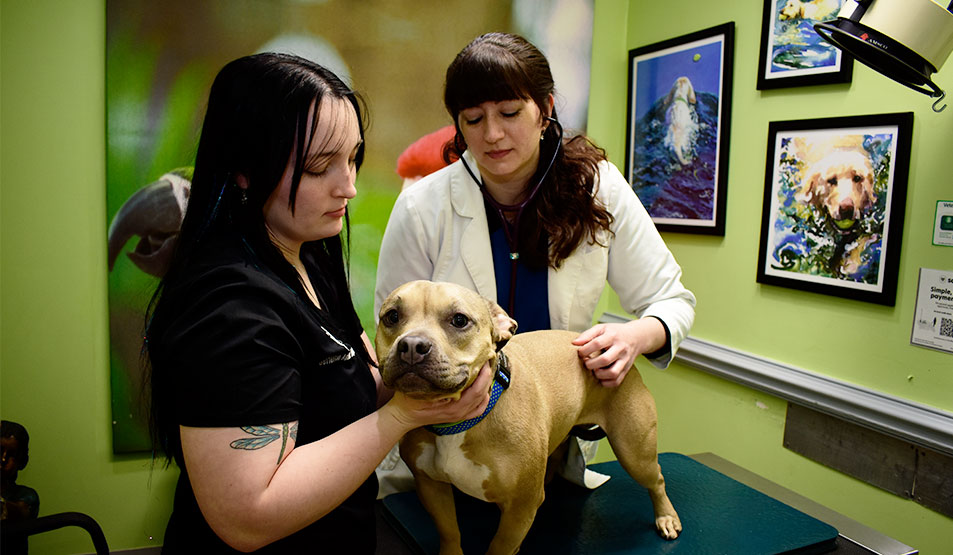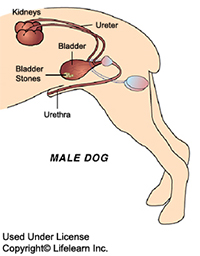
My Pet Cannot Urinate
My Pet Can’t Urinate. This is a TRUE pet emergency, call us immediately 502-966-4104
There are many reasons why your pet is straining to urinate and the most common cause in dogs is bladder stones. Cats develop “crystals” (Feline Lower Urinary Tract Disease) that form a “plug” and is most commonly a problem in male cats. A urinalysis and x-ray are required to diagnose your pet’s problem.
Other causes can result from trauma (ruptured bladder or urethrae), Cancer (tumors inside the bladder can block the flow),or poor muscle tone of the bladder and urethral passage.
Feline Lower Urinary Tract Disease
Feline Lower Urinary Tract Disease (FLUTD) is a term used to describe a set of clinical signs associated with abnormal urination in cats. When the condition has no identifiable cause, it is called Feline Idiopathic Lower Urinary Tract Disease (iFLUTD) to indicate that this is an exclusionary diagnosis.
What are the clinical signs of feline lower urinary tract disease?
- Straining to urinate
- Bloody or discolored urine
- Frequent urinations
- Urinating in unusual locations
- Urethral obstruction or the inability to urinate
Prognosis for FLUTD
Once your cat has been diagnosed, unblocked and placed on the appropriate medications and diet, the long term prognosis is very good. This problem in cats is very DIET RELATED and once your kitty is stable on the Prescription Diet (we recommend Royal Canin S-O) then it is important to have a urinalysis checked regularly to check for crystals and not change the diet.

Bladder Stones in Dogs
Bladder stones (uroliths or cystic calculi) are rock-like formations of minerals that develop in the urinary bladder. There may be a large, single stone or a collection of stones that range in size from sand-like grains to gravel. It is common for a mixture of both small and large stones to be present. Both Male and female dogs can develop stones. Smaller stones will cause blockages much sooner in male dogs. It requires larger stones to block the passage of female dogs.
What are the clinical signs of bladder stones?
The most common signs that a dog has bladder stones are hematuria (blood in the urine) and dysuria (straining to urinate). Hematuria occurs because the stones rub against the bladder wall, irritating and damaging the tissue and causing bleeding. Dysuria may result from inflammation and swelling of the bladder walls or the urethra, from muscle spasms, or due to a physical obstruction to urine flow caused by the presence of the stones.
“If the obstruction is not relieved, the bladder may rupture”
How quickly can bladder stones form?
Bladder stones can develop within a few weeks or they may take months to form. Speed of growth will usually depend on the quantity of crystalline material present and the degree of infection present. Although it may take months for a large stone to grow, some sizable stones have been documented to form in as little as two weeks.
How are bladder stones diagnosed?
The symptoms of bladder stones are similar to those of an uncomplicated bladder infection or cystitis. Most dogs that have a bladder infection do not have bladder stones. Therefore, we do not conclude that a dog has bladder stones based only on these common clinical signs.
Some bladder stones can be palpated (felt with the fingers) through the abdominal wall. However, failure to palpate them does not rule them out. Some stones are too small to be felt in this manner, or the bladder may be too inflamed and painful to allow palpation.
“Most bladder stones are visible on radiograph (x-rays) or an ultrasound bladder examination.”
How are bladder stones treated?
In general, there are three main treatment options for bladder stones:
- surgical removal
- non-surgical removal by urohydropropulsion
- dietary dissolution.
The specific treatment that is recommended for your dog will depend on the type of stone that is present. Your veterinarian will discuss the pros and cons of each treatment option with you in more detail, based on your dog’s individual circumstances.





